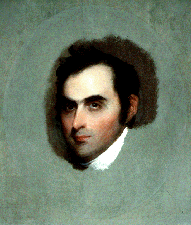 |
This portrait, although unfinished, is a beautiful depiction of Webster
as a young man, fresh from his victory in the Dartmouth College Case. Following
the College's success, it was decided that portraits of the attorneys who
represented the College be commissioned. For this task, Gilbert Stuart
was chosen. Stuart was a well-known portraitist of the period who had passed
his prime and was in his decline. His style and schedule were often sporadic,
and portraits, such as this one, might sit unfinished indefinitely. Stuart
later did a complete portrait of Webster, but its quality does not approach
that of this unfinished work. |

